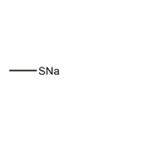Description
Sodium methanethiolate or sodium thiomethoxide (CH3SNa, MeSNa) is the sodium conjugate base of methanethiol. This compound is commercially available as a white solid. Sodium Methanethiolate is used as a nucleophile in organic synthesis. This compound is also being used as a reagent to synthesize thiol-based suberoylanilide hydroxamic acid (SAHA) analogues, compounds that act as potent histone deacetylase inhibitors. It reacts with trifluoroacetic acid and water to produce the active form of sodium trifluoroacetate. The reaction mechanism is likely due to the formation of a bicyclic heterocycle that has been shown to be effective against a number of bacteria.
Chemical Properties
Very faint yellowish red clear liquid
Uses
Used to prepare a C-21 thioether of methyl 16-prednisolonecarboxylate by mesylate displacement.
Uses
Sodium thiomethoxide is a strong nucleophile used for the synthesis of methyl aryl sulfides from halo-arenes. Alkanethiolates are efficient reagents for SN2 dealkylation of esters and aryl ethers.
Reactivity Profile
Sodium thiomethoxide is a powerful nucleophile that can be used to prepare methylthioether and other organic compounds like ethyl bromide. Its hydrolysis in moist air produces methanethiol, which has a low odor threshold and a noxious fecal smell.
reaction suitability
core: sodium
Purification Methods
Dissolve the salt (10g) in EtOH (10mL) and add Et2O (100mL). Cool and collect the precipitate, wash it with Et2O and dry it in a vacuum. It is a white powder which is very soluble in EtOH and H2O. [Billmann & Jensen Bull Soc Chim Fr 3 2318 1936, Beilstein 1 III 1212.]






